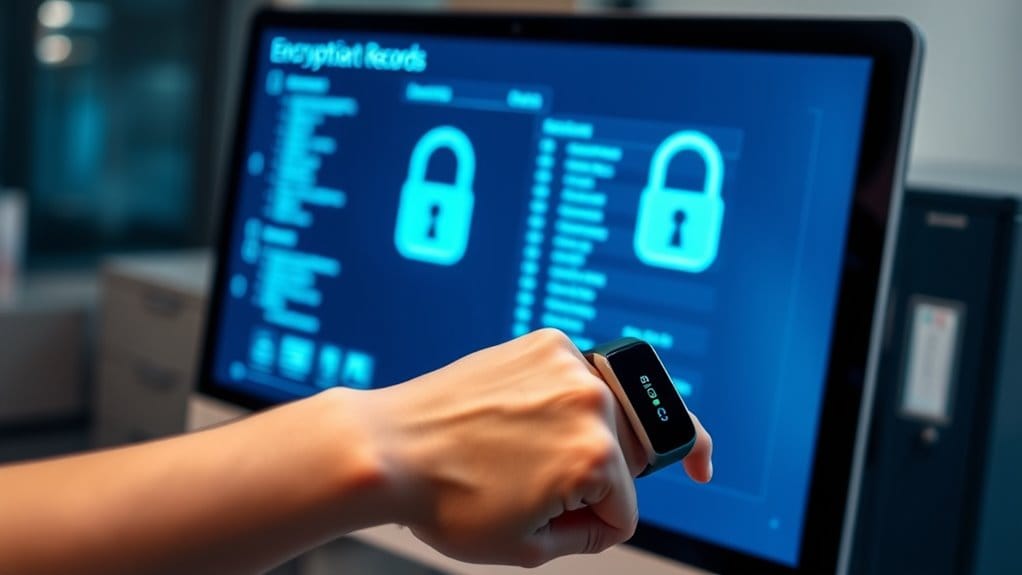3 Best Secure Solutions for Patient Record Protection
When it comes to protecting patient records, you can't overlook the importance of secure solutions. Implementing advanced data encryption techniques can greatly enhance the confidentiality of sensitive information. Coupled with robust access control measures, you can guarantee that only authorized personnel can access these records. However, without thorough monitoring and auditing processes, potential vulnerabilities might go unnoticed. So, what are the specific strategies and technologies that can help you achieve these security goals? If you need assistance with these topics, feel free to contact us. We can connect you with experts who can provide tailored solutions to enhance your patient record protection.
Advanced Data Encryption Techniques
In the domain of data protection, advanced data encryption techniques play an essential role in safeguarding sensitive patient records.
You'll find that employing robust encryption methods is critical for maintaining confidentiality and integrity in healthcare data management. Symmetric encryption, such as the Advanced Encryption Standard (AES), is widely recognized for its efficiency in securing large volumes of data. Healthcare data encryption not only protects patient information but also enhances compliance with privacy regulations.
However, as threats evolve, so must your encryption strategies.
Consider integrating emerging technologies like quantum encryption and homomorphic encryption. Quantum encryption leverages the principles of quantum mechanics, offering theoretically unbreakable protection against unauthorized access. This can be particularly beneficial in an era of increasing cyber threats.
On the other hand, homomorphic encryption allows you to perform computations on encrypted data without decrypting it, ensuring privacy during data analysis.
Robust Access Control Measures
Effective access control measures are essential for protecting patient records and ensuring that sensitive information remains confidential. By implementing role-based access, you can tailor access levels to individual job functions, allowing only authorized personnel to view specific patient information. This not only streamlines data management but also greatly mitigates the risk of unauthorized access to sensitive medical records.
Utilizing electronic access systems enhances security protocols by replacing traditional paper-based methods, which can be vulnerable to breaches. These systems provide centralized management, facilitating better control over patient data and ensuring compliance with regulations like the HIPAA Security Rule. Additionally, the increased need for robust access control can be attributed to the transition to electronic health records, highlighting the importance of maintaining security in a digital environment.
Incorporating Identity and Access Management (IAM) solutions further regulates who can access Electronic Health Records (EHRs). With IAM, you can prevent unauthorized access and maintain patient privacy, forming a vital part of your overall cybersecurity strategy.
Additionally, implementing multi-factor authentication (MFA) strengthens access control by requiring multiple verification methods, such as passwords and biometric data. MFA makes it considerably more difficult for hackers to gain entry, ensuring that your security protocols remain robust and adaptable to evolving threats in the healthcare landscape.
Comprehensive Monitoring and Auditing
Extensive monitoring and auditing are fundamental components in safeguarding patient records and guaranteeing adherence to regulatory standards. By employing Computer-Assisted Audit Techniques (CAAT), you can efficiently gather and analyze electronic records, pinpointing compliance challenges and trends. This not only enhances audit effectiveness but also saves time and minimizes errors across various areas, including medical coding and billing. Longitudinal records provide a complete picture of a patient's health journey, enabling more effective audits and compliance evaluations.
Random audits play an essential role in evaluating compliance and liability risks by sampling cases against established regulations. They help determine when a deeper examination is necessary, proactively identifying potential threats in your system. Tools like the Patient Case Audit Worksheet facilitate thorough evaluations of informed consent, treatment adherence, and data management quality.
Moreover, maintaining high data management standards is critical. Regular audits guarantee documentation is complete and timely, thereby reducing recurring deficiencies. Compliance with HIPAA and other regulations demands consistent performance monitoring and self-audits to mitigate risks of human error.
Ultimately, extensive monitoring and auditing not only protect patient records but also enhance the overall quality of healthcare delivery, guaranteeing you remain committed to serving your patients effectively and safely.
Frequently Asked Questions
What Role Does Antivirus Software Play in Patient Record Protection?
Antivirus software enhances patient record protection through its malware detection capabilities. By identifying and neutralizing threats, it guarantees antivirus effectiveness, safeguarding sensitive data from breaches while maintaining the integrity of critical healthcare systems for ideal patient care.
How Often Should Software Updates and Patches Be Applied?
Isn't it essential to maintain patient safety? You should apply updates regularly, ideally monthly or quarterly, while prioritizing critical patch management. This guarantees vulnerabilities are addressed promptly, minimizing risks and maintaining operational integrity.
What Are the Best Practices for Mobile Device Security?
To guarantee mobile device security, implement mobile encryption to protect data and enable biometric authentication for user access. Regularly update your devices, control app permissions, and use secure connections to minimize vulnerabilities.
How Can Staff Training Improve Patient Data Protection?
Staff training enhances patient data protection by fostering staff engagement and ensuring compliance training addresses current threats. This equips you to handle sensitive information responsibly, reducing risks associated with human error and improving overall security practices.
What Should Be Included in a Data Protection Strategy?
In your data protection strategy, prioritize data encryption, enforce access control, implement regular audits, provide staff training, and establish incident response protocols. This all-encompassing approach guarantees sensitive information remains secure while fostering trust and compliance.
Conclusion
In a world where data breaches lurk like shadows, employing advanced encryption, robust access controls, and thorough monitoring isn't just advisable—it's absolutely imperative. You're not merely protecting patient records; you're fortifying a fortress against insidious threats that could unravel trust and compromise lives. By implementing these unparalleled solutions, you're not just meeting compliance; you're setting an unassailable standard in healthcare data security that echoes through the industry, safeguarding sensitive information with the utmost vigilance.
If navigating these complexities feels overwhelming, remember that expert assistance is just a call away. Our team is here to help you tackle these challenges, allowing you to save time, reduce stress, and enhance your dental practice. By reaching out to us, you can ensure that your patient record protection measures are not only effective but also seamlessly integrated into your operations. Together, we can strengthen your security posture and enhance the trust your patients place in you.





